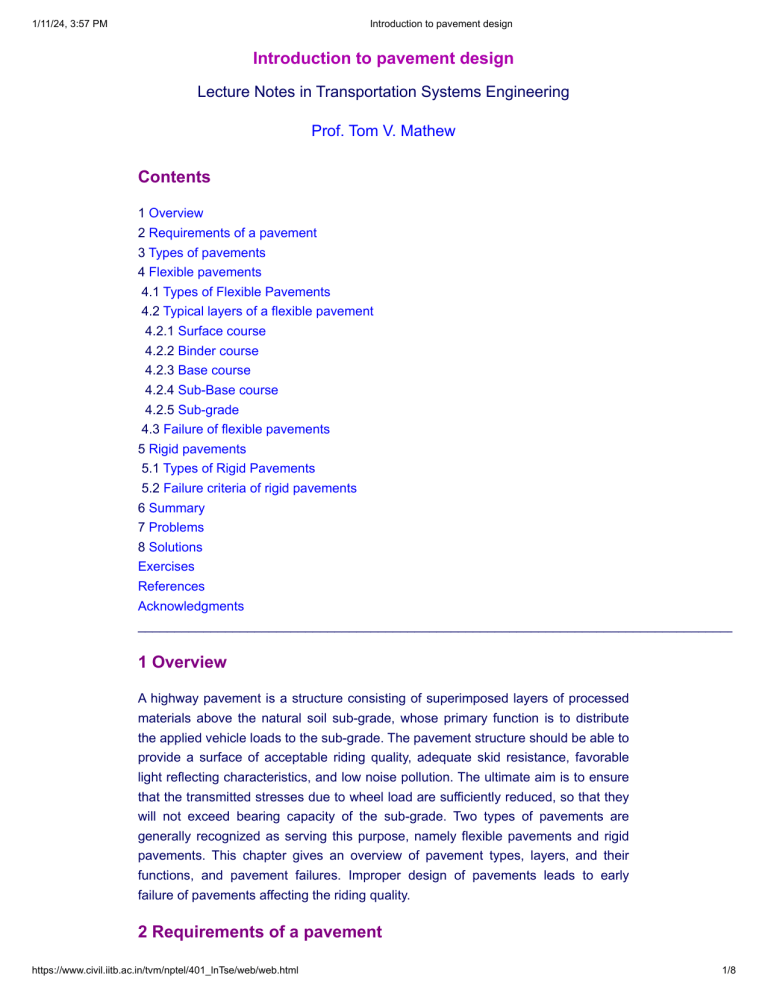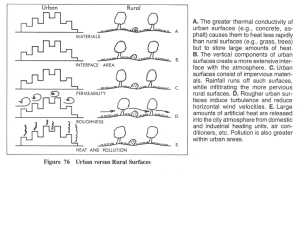
1/11/24, 3:57 PM Introduction to pavement design Introduction to pavement design Lecture Notes in Transportation Systems Engineering Prof. Tom V. Mathew Contents 1 Overview 2 Requirements of a pavement 3 Types of pavements 4 Flexible pavements 4.1 Types of Flexible Pavements 4.2 Typical layers of a flexible pavement 4.2.1 Surface course 4.2.2 Binder course 4.2.3 Base course 4.2.4 Sub-Base course 4.2.5 Sub-grade 4.3 Failure of flexible pavements 5 Rigid pavements 5.1 Types of Rigid Pavements 5.2 Failure criteria of rigid pavements 6 Summary 7 Problems 8 Solutions Exercises References Acknowledgments __________________________________________________________________________________ 1 Overview A highway pavement is a structure consisting of superimposed layers of processed materials above the natural soil sub-grade, whose primary function is to distribute the applied vehicle loads to the sub-grade. The pavement structure should be able to provide a surface of acceptable riding quality, adequate skid resistance, favorable light reflecting characteristics, and low noise pollution. The ultimate aim is to ensure that the transmitted stresses due to wheel load are sufficiently reduced, so that they will not exceed bearing capacity of the sub-grade. Two types of pavements are generally recognized as serving this purpose, namely flexible pavements and rigid pavements. This chapter gives an overview of pavement types, layers, and their functions, and pavement failures. Improper design of pavements leads to early failure of pavements affecting the riding quality. 2 Requirements of a pavement https://www.civil.iitb.ac.in/tvm/nptel/401_lnTse/web/web.html 1/8 1/11/24, 3:57 PM Introduction to pavement design An ideal pavement should meet the following requirements: Sufficient thickness to distribute the wheel load stresses to a safe value on the sub-grade soil, Structurally strong to withstand all types of stresses imposed upon it, Adequate coefficient of friction to prevent skidding of vehicles, Smooth surface to provide comfort to road users even at high speed, Produce least noise from moving vehicles, Dust proof surface so that traffic safety is not impaired by reducing visibility, Impervious surface, so that sub-grade soil is well protected, and Long design life with low maintenance cost. 3 Types of pavements The pavements can be classified based on the structural performance into two, flexible pavements and rigid pavements. In flexible pavements, wheel loads are transferred by grain-to-grain contact of the aggregate through the granular structure. The flexible pavement, having less flexural strength, acts like a flexible sheet (e.g. bituminous road). On the contrary, in rigid pavements, wheel loads are transferred to sub-grade soil by flexural strength of the pavement and the pavement acts like a rigid plate (e.g. cement concrete roads). In addition to these, composite pavements are also available. A thin layer of flexible pavement over rigid pavement is an ideal pavement with most desirable characteristics. However, such pavements are rarely used in new construction because of high cost and complex analysis required. 4 Flexible pavements Flexible pavements will transmit wheel load stresses to the lower layers by grain-tograin transfer through the points of contact in the granular structure (see Figure 1). Figure 1: Load transfer in granular structure The wheel load acting on the pavement will be distributed to a wider area, and the stress decreases with the depth. Taking advantage of this stress distribution characteristic, flexible pavements normally has many layers. Hence, the design of flexible pavement uses the concept of layered system. Based on this, flexible pavement may be constructed in a number of layers and the top layer has to be of best quality to sustain maximum compressive stress, in addition to wear and tear. https://www.civil.iitb.ac.in/tvm/nptel/401_lnTse/web/web.html 2/8 1/11/24, 3:57 PM Introduction to pavement design The lower layers will experience lesser magnitude of stress and low quality material can be used. Flexible pavements are constructed using bituminous materials. These can be either in the form of surface treatments (such as bituminous surface treatments generally found on low volume roads) or, asphalt concrete surface courses (generally used on high volume roads such as national highways). Flexible pavement layers reflect the deformation of the lower layers on to the surface layer (e.g., if there is any undulation in sub-grade then it will be transferred to the surface layer). In the case of flexible pavement, the design is based on overall performance of flexible pavement, and the stresses produced should be kept well below the allowable stresses of each pavement layer. 4.1 Types of Flexible Pavements The following types of construction have been used in flexible pavement: Conventional layered flexible pavement, Full - depth asphalt pavement, and Contained rock asphalt mat (CRAM). Conventional flexible pavements are layered systems with high quality expensive materials are placed in the top where stresses are high, and low quality cheap materials are placed in lower layers. Full - depth asphalt pavements are constructed by placing bituminous layers directly on the soil sub-grade. This is more suitable when there is high traffic and local materials are not available. Contained rock asphalt mats are constructed by placing dense/open graded aggregate layers in between two asphalt layers. Modified dense graded asphalt concrete is placed above the sub-grade will significantly reduce the vertical compressive strain on soil sub-grade and protect from surface water. 4.2 Typical layers of a flexible pavement Typical layers of a conventional flexible pavement includes seal coat, surface course, tack coat, binder course, prime coat, base course, sub-base course, compacted sub-grade, and natural sub-grade (Figure 2). Seal Coat: Seal coat is a thin surface treatment used to water-proof the surface and to provide skid resistance. Tack Coat: Tack coat is a very light application of asphalt, usually asphalt emulsion diluted with water. It provides proper bonding between two layer of binder course and must be thin, uniformly cover the entire surface, and set very fast. Prime Coat: Prime coat is an application of low viscous cutback bitumen to an absorbent surface like granular bases on which binder layer is placed. It provides bonding between two layers. Unlike tack coat, prime coat penetrates into the layer below, plugs the voids, and forms a water tight surface. https://www.civil.iitb.ac.in/tvm/nptel/401_lnTse/web/web.html 3/8 1/11/24, 3:57 PM Introduction to pavement design Figure 2: Typical cross section of a flexible pavement 4.2.1 Surface course Surface course is the layer directly in contact with traffic loads and generally contains superior quality materials. They are usually constructed with dense graded asphalt concrete(AC). The functions and requirements of this layer are: It provides characteristics such as friction, smoothness, drainage, etc. Also it will prevent the entrance of excessive quantities of surface water into the underlying base, sub-base and sub-grade, It must be tough to resist the distortion under traffic and provide a smooth and skid- resistant riding surface, It must be water proof to protect the entire base and sub-grade from the weakening effect of water. 4.2.2 Binder course This layer provides the bulk of the asphalt concrete structure. It’s chief purpose is to distribute load to the base course The binder course generally consists of aggregates having less asphalt and doesn’t require quality as high as the surface course, so replacing a part of the surface course by the binder course results in more economical design. 4.2.3 Base course The base course is the layer of material immediately beneath the surface of binder course and it provides additional load distribution and contributes to the sub-surface drainage It may be composed of crushed stone, crushed slag, and other untreated or stabilized materials. 4.2.4 Sub-Base course The sub-base course is the layer of material beneath the base course and the primary functions are to provide structural support, improve drainage, and reduce the intrusion of fines from the sub-grade in the pavement structure If the base course is open graded, then the sub-base course with more fines can serve as a filler https://www.civil.iitb.ac.in/tvm/nptel/401_lnTse/web/web.html 4/8 1/11/24, 3:57 PM Introduction to pavement design between sub-grade and the base course A sub-base course is not always needed or used. For example, a pavement constructed over a high quality, stiff sub-grade may not need the additional features offered by a sub-base course. In such situations, sub-base course may not be provided. 4.2.5 Sub-grade The top soil or sub-grade is a layer of natural soil prepared to receive the stresses from the layers above. It is essential that at no time soil sub-grade is overstressed. It should be compacted to the desirable density, near the optimum moisture content. 4.3 Failure of flexible pavements The major flexible pavement failures are fatigue cracking, rutting, and thermal cracking. The fatigue cracking of flexible pavement is due to horizontal tensile strain at the bottom of the asphaltic concrete. The failure criterion relates allowable number of load repetitions to tensile strain and this relation can be determined in the laboratory fatigue test on asphaltic concrete specimens. Rutting occurs only on flexible pavements as indicated by permanent deformation or rut depth along wheel load path. Two design methods have been used to control rutting: one to limit the vertical compressive strain on the top of subgrade and other to limit rutting to a tolerable amount (12 mm normally). Thermal cracking includes both low-temperature cracking and thermal fatigue cracking. 5 Rigid pavements Rigid pavements have sufficient flexural strength to transmit the wheel load stresses to a wider area below. A typical cross section of the rigid pavement is shown in Figure 3. Compared to flexible pavement, rigid pavements are placed either directly on the prepared sub-grade or on a single layer of granular or stabilized material. Since there is only one layer of material between the concrete and the sub-grade, this layer can be called as base or sub-base course. Figure 3: Typical Cross section of Rigid pavement In rigid pavement, load is distributed by the slab action, and the pavement behaves like an elastic plate resting on a viscous medium (Figure 4). Rigid pavements are constructed by Portland cement concrete (PCC) and should be analyzed by plate theory instead of layer theory, assuming an elastic plate resting on viscous foundation. Plate theory is a simplified version of layer theory that assumes the concrete slab as a medium thick plate which is plane before loading and to https://www.civil.iitb.ac.in/tvm/nptel/401_lnTse/web/web.html 5/8 1/11/24, 3:57 PM Introduction to pavement design remain plane after loading. Bending of the slab due to wheel load and temperature variation and the resulting tensile and flexural stress. Figure 4: Elastic plate resting on Viscous foundation 5.1 Types of Rigid Pavements Rigid pavements can be classified into four types: Jointed plain concrete pavement (JPCP), Jointed reinforced concrete pavement (JRCP), Continuous reinforced concrete pavement (CRCP), and Pre-stressed concrete pavement (PCP). Jointed Plain Concrete Pavement: are plain cement concrete pavements constructed with closely spaced contraction joints. Dowel bars or aggregate interlocks are normally used for load transfer across joints. They normally has a joint spacing of 5 to 10m. Jointed Reinforced Concrete Pavement: Although reinforcements do not improve the structural capacity significantly, they can drastically increase the joint spacing to 10 to 30m. Dowel bars are required for load transfer. Reinforcements help to keep the slab together even after cracks. Continuous Reinforced Concrete Pavement: Complete elimination of joints are achieved by reinforcement. 5.2 Failure criteria of rigid pavements Traditionally fatigue cracking has been considered as the major, or only criterion for rigid pavement design. The allowable number of load repetitions to cause fatigue cracking depends on the stress ratio between flexural tensile stress and concrete modulus of rupture. Of late, pumping is identified as an important failure criterion. Pumping is the ejection of soil slurry through the joints and cracks of cement concrete pavement, caused during the downward movement of slab under the heavy wheel loads. Other major types of distress in rigid pavements include faulting, spalling, and deterioration. 6 Summary Pavements form the basic supporting structure in highway transportation. Each layer of pavement has a multitude of functions to perform which has to be duly considered during the design process. Different types of pavements can be adopted depending upon the traffic requirements. Improper design of pavements leads to early failure of pavements affecting the riding quality also. https://www.civil.iitb.ac.in/tvm/nptel/401_lnTse/web/web.html 6/8 1/11/24, 3:57 PM Introduction to pavement design 7 Problems 1. The thin layer of bitumen coating between an existing bituminous layer and a new bituminous layer is: a. Seal coat b. Intermediate coat c. Tack coat d. Prime coat 2. Rigid pavements are designed by a. Rigid plate theory b. Elastic plate theory c. Infinite layer theory d. Interlocking of aggregates 8 Solutions 1. The thin layer of bitumen coating between an existing bituminous layer and a new bituminous layer is: a. Seal coat b. Intermediate coat c. Tack coat√ d. Prime coat 2. Rigid pavements are designed by a. Rigid plate theory b. Elastic plate theory√ c. Infinite layer theory d. Interlocking of aggregates Exercises 1. Not Available References 1. Y. H Huang. Pavement analysis and Design. Prentice-Hall, Englewood Cliffs, New Jersey, 1993. Acknowledgments I wish to thank several of my students and staff of NPTEL for their contribution in this lecture. I also appreciate your constructive feedback which may be sent to tvm@civil.iitb.ac.in Prof. Tom V. Mathew Department of Civil Engineering Indian Institute of Technology Bombay, India ________________________________________________________________________________ https://www.civil.iitb.ac.in/tvm/nptel/401_lnTse/web/web.html 7/8 1/11/24, 3:57 PM Introduction to pavement design Thu Jan 10 12:41:50 IST 2019 https://www.civil.iitb.ac.in/tvm/nptel/401_lnTse/web/web.html 8/8


